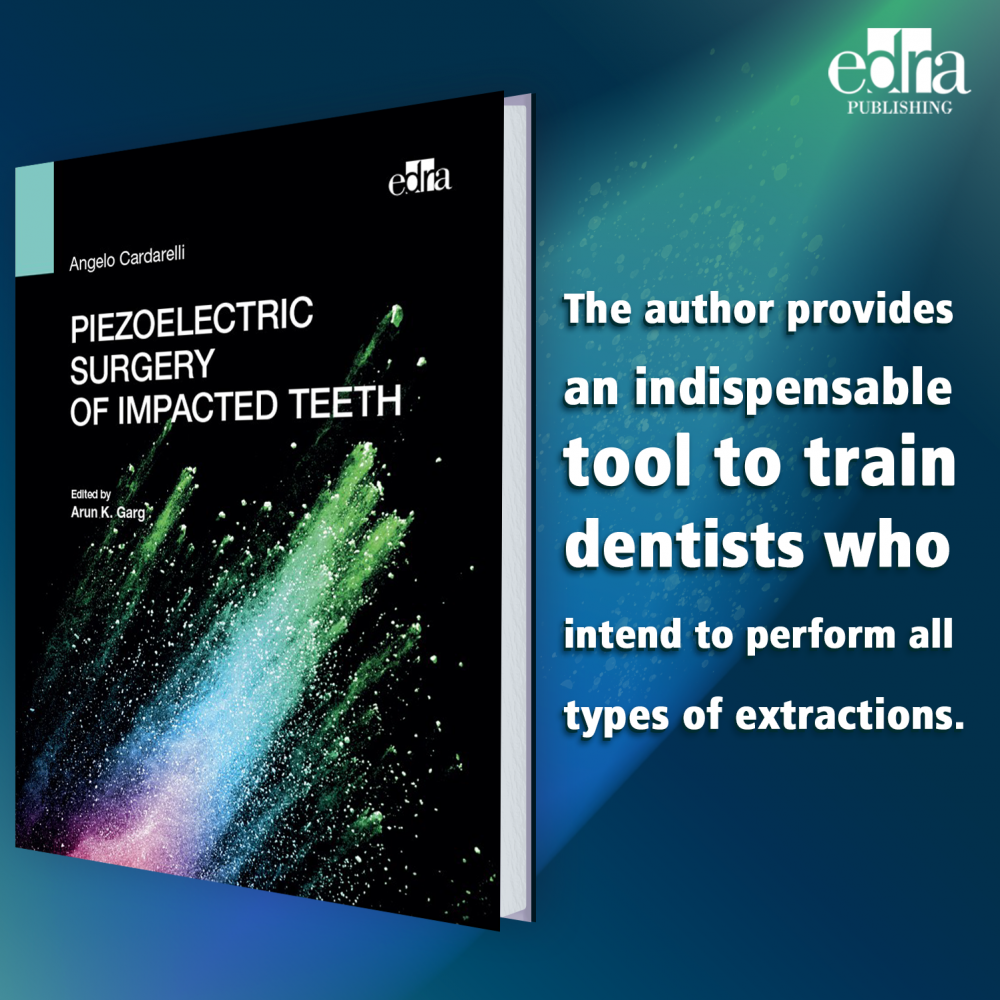
Odontología estética. Las facetas de la vida: en busca de la sonrisa perfecta
En busca de la sonrisa perfecta
Guía completa sobre restauración con carillas de porcelana, desde selección del caso hasta resultados predecibles con nuevas tecnologías.




The extraction of impacted dental elements is often referred to by maxillofacial surgeons. However, it can be handled as routinely as any other type of extraction. Piezoelectric surgery of impacted teeth, which involves reproducible procedures using a step-by-step approach in all types of cases, also allows dentists who approach the extraction of impacted elements less frequently to carefully prepare for the procedure and perform it, thereby minimizing possible post-surgical issues for the patient, such as biological risks. Using the most innovative techniques, including the application of ultrasound in oral surgery and piezoelectric surgery, the author provides an indispensable tool to train and update dentists who intend to perform all types of extractions.
The extraction of impacted dental elements is often referred to maxillofacial surgeons. However, it can be handled as routinely as any other type of extraction. Piezoelectric surgery of impacted teeth, which involves reproducible procedures using a step-by-step approach in all types of cases, also allows dentists who approach the extraction of impacted elements less frequently to carefully prepare for the procedure and perform it, thereby minimizing possible post-surgical issues for the patient, such as biological risks. Using the most innovative techniques, including the application of ultrasound in oral surgery and piezoelectric surgery, the author provides an indispensable tool to train and update dentists who intend to perform all types of extractions.
Strengths
•This manual presents a protocol—unique in its kind—for the extraction of impacted teeth with the use of a piezoelectric instrument.
•This is the first manual to examine piezoelectric surgery of all impacted dental elements (not only wisdom teeth); in other volumes, the patient is treated only in individual chapters.
•The clarity of the text is enhanced with images and surgical photographs that illustrate every step of the cases presented
•Contains QR code to access digital content of each topic
Author:
Angelo Cardarelli
Adjunct Professor at the Faculty of Medicine and Surgery of the Vita-Salute San Raffaele University of Milan; Scientific Consultant in the Department of Dentistry IRCCS San Raffaele Hospital Milan; Member of the American International Academy of Extractive Surgery.
Table of contents:
Chapter 1
Surgical anatomy of the jaws
Chapter 2
Diagnostic imaging and radiological anatomy
Chapter 3
Surgicaltools andpreparation oftheoperative area
Chapter 4
Local anesthesia and intravenous sedation: technique and analysis of failures
Chapter 5
Flap designs and suturing techniques
Chapter 6
Piezoelectric surgery: applications and protocols
Chapter 7
Surgery of impacted upper and lower third molars
Chapter 8
Germectomy Indications and surgical technique
Chapter 9
Surgical-orthodontic recovery and supernumerary teeth
Chapter 10
Pre- and postsurgical pharmacology and management of patients at risk
Chapter 11
Intraoperative and postoperative complications
Ficha técnica
Referencias específicas
En busca de la sonrisa perfecta
Guía completa sobre restauración con carillas de porcelana, desde selección del caso hasta resultados predecibles con nuevas tecnologías.
The introduction of osseointegrated dental implants soon 50 years ago has indeed revolutionized dentistry. The scientific evaluation of their use has shown good and increasingly successful treatment outcomes. A prerequisite though is the availability of sufficient bone volumes to ensure integration and acceptable aesthetic results. In this book various surgical techniques, using different augmentation materials, are described and explained. The aim has been to highlight minimally invasive surgical techniques, which leads to less risk of morbidity and reduces treatment time. Readers will enjoy a comprehensive atlas providing some practical advice for everyday surgical practice based on solid scientific evidence.
The white coat has its roots in the Arabic word ‘qamiç’, meaning a tunic, a long, white linen underrobe worn by priests during the celebration of divine offices, but also in the Greek word ‘kámasos’, a square-shaped, sleeveless garment made of cotton, linen, or silk. The ancient Romans used it as an undergarment and adopted the Hellenic name. The first ones were beige, then they took on various colors depending on the activity of professionals and artists. However, the first person to wear a white coat was not a doctor.
When unpredictable, catastrophic and disabling events happen into all sectors of the economy and social life, the impact of the change becomes immediate, with an acceleration of the processes that almost always leads to a concentration and restructuring of the activities. In our case of the dental offer. In the next future it will occur a physiological reduction of the dental offices that will be larger on average, organized, competitive, entrepreneurial. In this context matters relating to management and business economics should become part of the cultural heritage of dentists, at least those who run their own business.
The book deals with the reconstruction of posterior teeth with direct and indirect adhesive techniques and consist of two volumes. This text, the second reconstruction volume, deals with indirect techniques, defining the current indications but also describing the Morphology Driven Preparation Technique (MDPT), an innovative cavity design applicable to all types of conventional adhesively cemented restorations. An essential added value are all the procedures to treat sub-gingival lesions tackled with restorative methods integrated with surgical procedures related to caries, fractures, cervical root resorption.